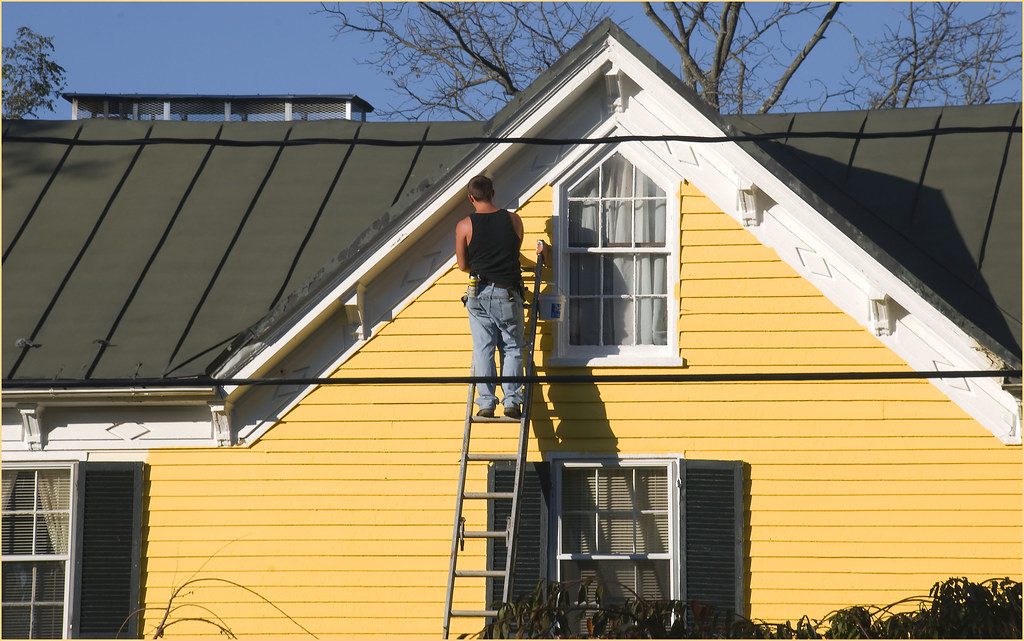When professionally constructed, a scaffold offers maximum stability and easy access to multiple levels outside a building. They are usually only ever considered for longer projects outside a building, such as large repaints or brickwork. But there are quite a few reasons why you may not want to use one. Here we outline some of the alternatives when you want to paint your house but don’t want the expense or inconvenience of scaffolding.
But what are those alternatives? Read on further to find out!
Downsides to Hiring a Scaffold Installation Service
If you’re considering a scaffold for painting, you probably have a lot of work to do, and the majority of it is at a decent height. Hiring scaffolding may at first seem like a decent suggestion then, until you receive your quote.
There are quite a few types of scaffold services on offer, and almost all of them have costs in the hundreds. If you were to hire a scaffold for a two-story semi-detached house, you’d likely be looking at something between £650 to £1100 in fees per week. You typically pay less the less scaffolding you require, so a smaller property would fall into the lower end of the bracket.
Nonetheless, we’ve outlined three options for those looking for something other than expensive hired scaffolding.
Best Ladder for Painting Outside
The biggest advantage ladders have over scaffolds is that they are usually multi-purpose, and you can keep them for life. Whereas a scaffold would take a while to set up and take down, a ladder takes less than a minute to be stationed where it needs to be. To add to this, there is a wide range of weights that a ladder can come in depending on your required use. Aluminium ladders have the lowest weight, for example, whilst wood is the heaviest.
Despite their adaptability, ladders often have one or two specialities or specific purposes. For ladders on uneven ground, you’re better off with a tripod ladder that can stabilise your balance with its hind leg, which comes with a spike or a rubber grip. If you need to climb and paint at heights, then a classic extension ladder will suit your needs. Steel-locking auto-clamps will keep you in place as you paint safely at a height.
Inevitably, the lack of scaffolding means that you will have to pick up the ladder and readjust it every so often across a horizontal plane. That being said, if that axis is at a low height, there’s a perfect instrument for your troubles. The multi-purpose ladder is true to its name. Not only can this ladder reach up to 4.75 Metres extended, but the joints on the frame of the ladder mean it can bend into different shapes, including that of a pseudo-scaffold.
If you value the stability that scaffolding provides for standing on, there are options you can add to ladders to make them more comfortable and practical for use. Step platforms, for example, allow you greater safety and comfort, and even a place to rest paint or tools while on the ladder.
In essence, ladders are best for those who need flexible equipment for jobs of medium effort that can be done without compromising safety. There’s also the bonus that even after you have completed your painting outside, your ladder can be reused for a wide variety of other tasks out there.
Best Tool for Painting Outside
Yes, a tool. Something you can hold in your hand as opposed to having to lug around. Relatively inexpensive and flexible, the best hand tool for an outdoor painting job is an extension pole to which you can add an array of different attachments
The pole is extendable and can reach high up on the surface of any wall. For painting, you can use the roller extension and reach heights of up to sixteen feet. This would save you the effort of manipulating ladders if your workload is not overly high.
The biggest pro, as you can expect, is the low price. Cheap and inexpensive, this is the best option if your budget simply isn’t high enough to afford heavier equipment such as ladders or scaffolding.
Not only this, but you can use your extension pole for other tasks simply by adding different attachments, whether that be a scraper, paintbrush, or something else. The retractable nature of an extension pole widens the possibilities of its usage. For example, you can add a brush to the end of an extension pole, and use it to clean areas hard to reach, or perhaps just areas you’d rather not touch yourself by hand.
Also, there’s little to no risk factor whatsoever when using an extension pole – as long as there are no electricity cables nearby. Although BPS prides itself on safety, it’s worth remembering that the vast majority of all ladder falls comes as a result of misuse.
Best Access Platforms for Painting Outside
Each platform has its own name and use. Some have wheels and some are stationary, for example. Nonetheless, access platforms exist to replicate the stability that scaffolding provides.
To replicate the stability that a scaffold provides, you may consider getting yourself an access platform. They come in many shapes and sizes. Some are more suited to lower-level action, and if they aren’t high enough, they provide a good stable ground to combine with an extension pole.
Alternatively, you could look at getting a scaffold tower. There’s a difference between scaffolding and a scaffold tower. Whereas scaffolding is a series of interlocking metal poles and wooden boards, set in a stationary position, a scaffold tower, however, is a vertical tower on wheels. You can adjust the position of it easily, as well as customise precisely where the platforms go, giving you both adjustable horizontal and vertical positions.
You might imagine a scaffold tower is difficult to set up, but our DIY Scaffold Tower is easy to assemble and disassemble. No complex tools or instructions are required, and we use colour coding to ensure ease of construction. Alternatively, our Trade Master Professional is one of our easiest and quickest of all towers to erect and dismantle towers, as it is built around a folding base. Take a look at this video for an idea of what to expect.
Conclusion
Whilst traditional scaffolding is very useful, especially when there is a requirement to be working above a certain height, it’s not for everybody, especially if you are planning on doing the outside painting yourself. Often it comes down to cost, and some of the options we have outlined give you the best possible opportunity of getting your painting work done safely and at a reasonable cost.
No related posts.



